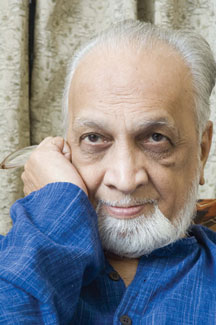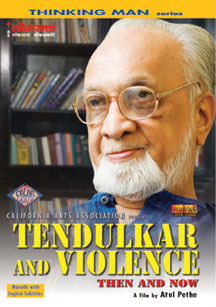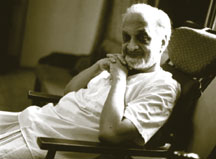Arts
Vijay Tendulkar's Critical Gaze

Flaying the dark underbelly of the middle-class.
|
When Vijay Tendulkar, the acclaimed Marathi playwright, died in Pune in May this year from the effects of myasthenia gravis, he had nudged a ripe 80. He was also nudging a rare kind of immortality in the world of Indian theater: few writers of any genre get recognized as arguably the “greatest ever” during their lifetime. The world at large — particularly western Europe — had saluted Tendulkar way back in the early 1970s after his most overtly political play Ghashiram Kotwal did the international rounds following a controversial run in India. That admittedly was a one-off glimpse of the playwright’s creative universe. But it was only a few years ago that critics and theater-lovers alike began undertaking a more holistic appraisal of Tendulkar’s ouvre.
The appraisal took varied forms. There was, for instance, the publication of The Tendulkar Omnibus (a collection of his most representative writings) edited by fellow playwright and director Makarand Sathe. Then an hour-long video documentary titled Tendulkar and Violence: Then and Now produced by the California Arts Association in which the playwright discussed his views on violence and its depiction. And finally came the Tendulkar festivals where several of his original Marathi plays were performed in various languages – including English – before packed halls in India and abroad, most notably in New York City. One reason Tendulkar’s death did not evoke the kind of frenzied look-back at his work probably lies in the fact that he was already feted with a multi-faceted retrospective of his work when still alive – an honor denied to most writers and artistes whose “genius” is often discovered only after they are dead. Such posthumous revaluation lacks an essential element: the writer’s own perspective of his work. In Tendulkar’s case, the organizers (read, his fans) were doubly blessed: Not only was he alive, kicking, and lucid, the usually reticent Vijay Tendulkar was actually in a mood to speak! Was it the case of an artiste seeking to set the record straight after years – even decades – of being misinterpreted by his admirers, and maligned by his detractors? And then choosing to articulate his arguments in a medium other than writing because he had well nigh exhausted that option? Or was it the instance of a sensitive individual and a concerned citizen letting out an anguished cry against a society slumbering in apathy? Or was it simply another example of old age and the loss of dear ones (his son, wife and daughter died in the span of a year) loosening the tongue of a lonely man? Whatever the reasons, geriatric or otherwise, even his closest friends were taken aback by the zest with which Tendulkar, who throughout his 50-plus-year writing and journalistic career had let his pen speak for itself, articulated his angst not only in media interviews but also on the public platform. His most forthright and dramatic speech was the one in which he wished he had a gun, so he could shoot the right-wing Gujarat Chief Minister Narendra Modi in retaliation against the genocide-like pogrom against the Muslims in that state. But in his private dealings as well, a certain left-handed humor became evident. Witness Tendulkar’s response (“I thought that was an ailment confined to famous film stars” – a veiled reference to Amitabh Bachchan’s “designer” ailments) on being told by the doctor that his diagnosis revealed an advanced stage of myasthenia gravis, a neurological disorder that debilitates the muscles. Tendulkar tore through the barrier of propriety with his searingly realistic plays. Armed with ruthless yet clinical dispassion, the playwright turned the genre of “social realism” on its head by wrenching the focus back on the individual. Not on the conventionally attired and properly presented Hero of the mainstream theater, mind you. But on Man in his primal avatar, denuded of his socially acceptable trappings and prey to the rawest of animal passions. In flaying the dark and hitherto unseen underbelly of the genteel and seemingly effete “civilized” classes of society, Tendulkar exposed us to a disturbing truth. No amount of ritualized role-playing and hypocrisy, the sage told us, can hide the fact that the beast of violence – physical or emotional – resides deep within us, and that events in the outside world are not its cause but its result. At best, the external event is but a trigger that sparks off the internal inferno. The unmentionable was, at last, mentioned.
Much in the manner of a life-long vegetarian who impulsively throws up his first morsel of meat, the strait-jacketed Marathi public rejected Vijay Tendulkar’s plays at first sight. One of Tendulkar’s initial efforts Shrimant (The Rich) met with such a disastrous audience response in 1956 that the playwright vowed never to write again. Thankfully for us, Tendulkar broke that vow, but Shrimant, despite its all-round rejection, carries the seed of later fruit. It depicts the sorry yet despicable predicament of a rich man who searches the marriage market to “buy” a suitable boy for his unmarried daughter who insists on keeping her bastard child. It is arguable that the liberalized atmosphere in the Indian society of the late 1960s, affected no doubt by anti-establishment movements in other parts of the world, was at least partly responsible for the receptivity to and the subsequent rise and popularity of Vijay Tendulkar as a playwright. A pointer to this observation is the fact that all the four major plays by him – Shantata, Court Chalu Ahey (Silence! The Court Is In Session), Gidhaade (The Vultures), Sakharam Binder and Ghashiram Kotwal (“Ghashiram, The Constable”) – were premiered on stage in that particularly fecund period in Indian creativity from the late 1960s to the mid 1970s. (This was also the sunshine phase of the Indian New Wave Cinema when the federal government allocated considerable sums of money to support young avant garde film-makers and produce their works.) Even more telling is the fact that while Tendulkar wrote Gidhaade in 1961, it had to wait till 1970 to be first mounted on the professional Marathi stage. One yardstick of the influence that a play exerts on the contemporary theater scene is its longevity as well as the number of languages into which it is translated and performed. By that measure, Tendulkar is without doubt the most influential playwright in the country: Ghashiram Kotwal with a tally of more than 6,000 performances worldwide, is believed to be the longest-running play in the history of Indian theater. Another yardstick of a play’s impact is the controversy it creates. It is difficult to recapture in words the shocked gasps from largely conservative family audiences which first heard a volley of swear-words in Sakharam Binder in the early 1970s. As a teenager accustomed to the normal routine of Indian (and particularly Marathi) theater, one had to pinch oneself to realize that such language was indeed a part of the play in progress and not the result of a personal hallucination. But was the intent merely to shock? Hardly. As the play ran its course, its dialogues no longer seemed out of place. In fact, as Tendulkar himself opined later, the shock was the result of the audience’s conditioned approach to experiencing a play. The establishment’s reaction – ranging from outrageous to ridiculously funny – to such controversy can be rather revealing. A brutalized character in Gidhaade is shown wearing a blood-stained sari to signify a forced abortion. The censors objected. So director Satydev Dubey changed the color of the stain from red to black, and asked the audience to think of it as red! The censors were apparently pacified. Ghashiram Kotwal has been wrongly interpreted as a historical play. To view it as such would be to devalue its true intent and worth. Tendulkar merely uses history as a backdrop to mull on the politics of power. The rise of a political ideology (such as fascism) in response to conducive social and economic circumstances, and how the masterminds behind this rise exploit and then discard people as pawns in a power game-these form the crux of the play’s enduring statement. The final lynching of Ghashiram by the Brahmin lumpen is its climactic tour de force.
But, in all fairness, the importance and greatness of Ghashiram Kotwal as a piece of theater transcends its various controversies. The play, seamlessly blending sophistication of form with universality of content, not only represents the high-point of Tendulkar’s career as a playwright, but also marks the farthest point to which any Indian play has pushed the frontiers of theatrical art. Fusing folk music traditions with those of sangeet natak (the Indian variant of the operatic form) and modern theater techniques including an innovative use of choreography, Ghashiram Kotwal traces the depths of immorality to which a sexual predator can descend and the extent to which the larger good of the people can be consequently compromised. The play’s climax, which made a powerful statement on group psychology and violence, coupled with the psychic explorations of his earlier works led to Tendulkar being awarded the 1974-75 Jawaharlal Nehru Fellowship, which enabled Tendulkar to spend time with convicts inside prisons, and even to witness three hangings. He emerged a strong opponent of the death penalty, and in an email chat with this writer several years later, wrote: “When anyone kills anyone and if it happens to be a collective killing, like the hanging is, those who hang [the convict] and not one person but a group of five to six persons, for each one of them, it’s a kind of a guilt on their conscience that they cannot forget easily.” It is always tempting to psychoanalyze the psychoanalyst. What forms the mental well-spring of Vijay Tendulkar’s concerns as a writer probing the depths of deviant minds? His small-town upbringing in a lower middle-class Saraswat Brahmin family in Kolhapur where he had to contend with an insane uncle, among others? And later, an elder sister who died an old spinster? Or the years spent in a gutter-ridden chawl in Bombay where he lived with his growing family in penurious circumstances, and saw life unvarnished by middle-class mores?
The last, according to a common friend, had a severe impact on the sensitive Tendulkar. It provided him the material for his future works, but the poverty also changed his outlook toward money. The friend talks in hushed tones about how ghost-writing Bollywood film scripts in the 1980s first brought much-needed financial succour to the Tendulkar family, but later got the writer hooked on to easy pickings. Curiously though, the offers came pouring in not because of his work on low-budget films such as Akriet, Akrosh, Manthan, etc. but because he was invited to a few abortive script sessions by the legendary Bollywood showmen Raj Kapoor and Yash Chopra! So you might well detect Tendulkar’s deft touch redeeming several of the run-of-the-mill masala film scripts of the 1980s. It is clear however that the writer will be best remembered for preparing theater-goers into accepting a different kind of play from a different kind of playwright. Apart from being a pioneer, he was gracious enough to mentor younger playwrights. After pushing open the door himself, he, in a manner of speaking, held it ajar for other lesser writers. |




